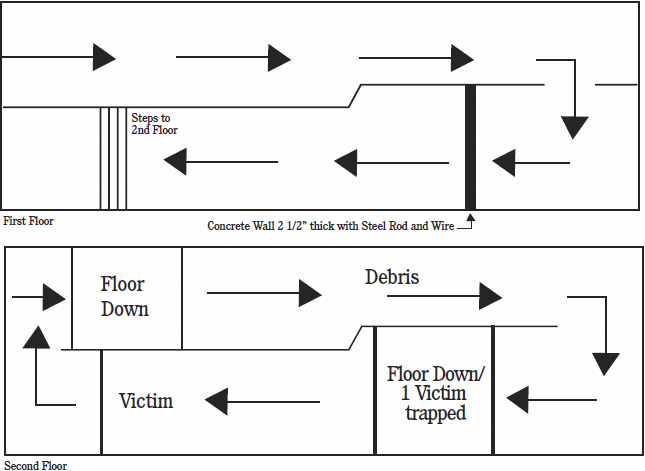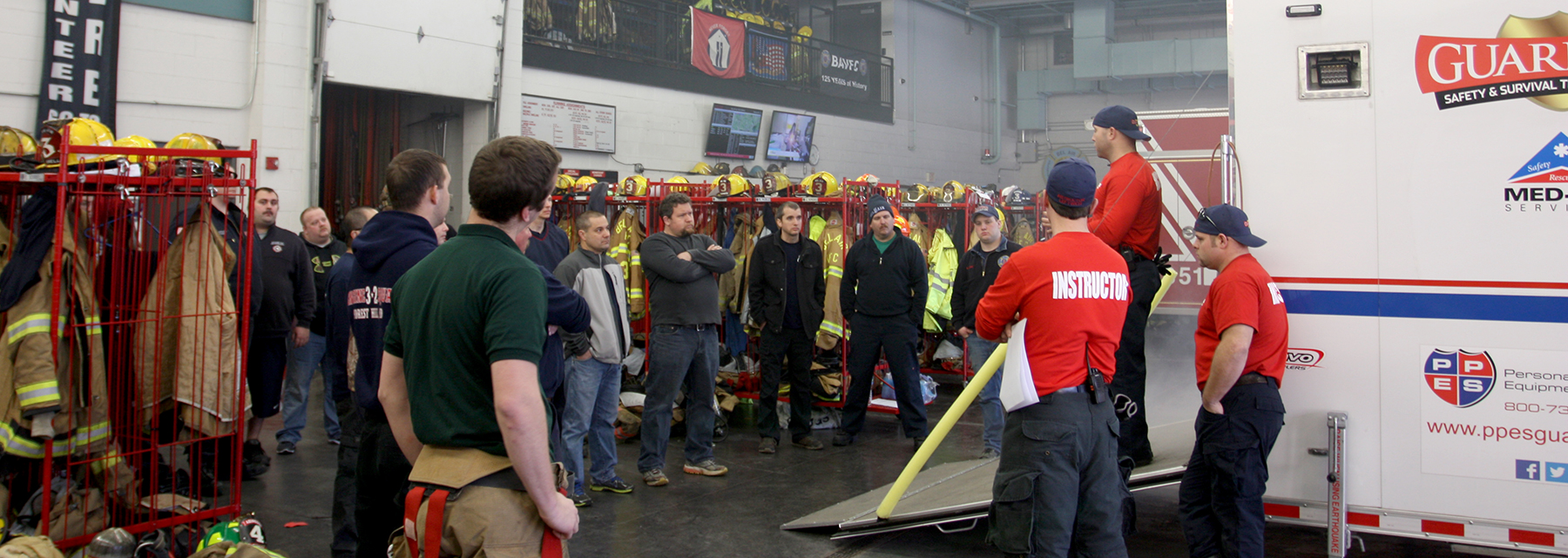
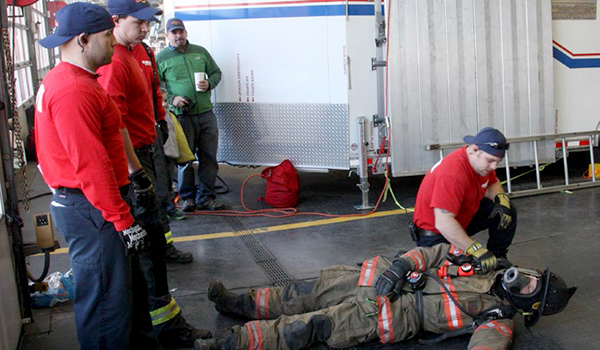
PPES offers a full range of training programs utilizing “classroom” presentations as well as realistic hands-on training in the Guardian®. These training sessions can be customized to suit a client’s specific needs.
Because of the Guardian® Safety and Survival Training Simulator’s ease of mobility, this life-saving instruction can be performed in a location that is convenient to the customer’s needs without disrupting day-to-day activity.
PPES draws upon a diverse group of training specialists to develop and conduct the wide spectrum of training courses that can be performed in conjunction with the Guardian®. From confined space, railroad accidents and gas leaks to earthquakes and structural collapses, the overriding concept is to teach the crucial survival skills necessary when the first responder is in a deadly situation. To that end, PPES instructors are fully experienced and certified in multiple training disciplines including all levels of firefighting techniques, bailouts, search and rescue, victim packaging and removal, forcible entry and RIT, among others. Since 1995, PPES has met the demands of over 12,000 first responders by providing lifesaving and survival training in an environment that’s as real as it gets.
The comprehensive list of skills and certifications includes:
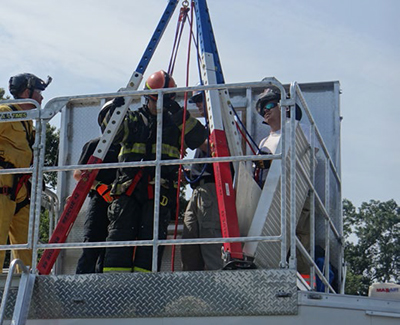
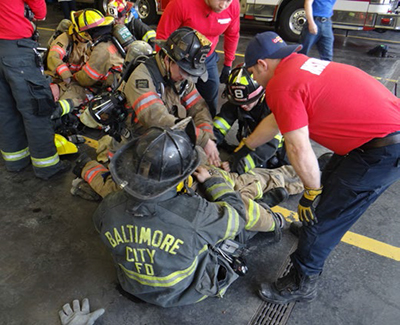
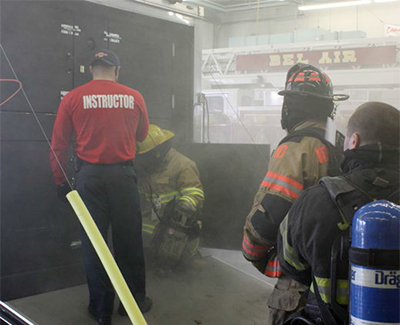
PPES Guardian® Training offers responders the most up-to-date and cutting- edge training. Programs are offered through interactive classroom presentations as well as realistic hands-on training opportunities or a combination of both. We specialize in customizing the various training classes below to suit your needs and also meet applicable OSHA and NFPA standards.
(3 hrs. Classroom/6-10 hrs. Practical)
This academy-style course is designed to promote confidence, motivation and team
building, by putting students into stressful situations. Instructors will apply stress to
the students both mentally as well as physically in this class. By placing the students
into stressful training scenarios, they will be better able to understand how the body
reacts to the effects of stress in an emergency situation. This course enables the
student to identify their weaknesses, as well as adapt and overcome the obstacles
placed in front of them. This course employs a boot camp like style of mental and
physical fatigue to achieve results. Students will receive positive as well as negative
reinforcement depending on how they perform the tasks in this course, with physical
exercise being handed out as negative reinforcement. Instructors will push students
to their limits in order to show them that they can push even farther. This class will
not only show the students how to perform tasks, but also show them how far they
can push themselves, which will give them confidence and motivation to better
themselves. (This course is a highly physical and mentally demanding class.)
(3-day Class)
Teaches the basic skills of becoming a junior firefighter.
Day 1: Classroom 3-4 hrs – turn out gear breakdown, SCBA breakdown, SCBA training.
Day 2: Basic practical evolutions (8-10 hrs.)
Day 3: Everything from Day 1 and 2 combined implemented into scenarios. Based on NFPA 1001 Standard for Firefighter Professional Qualifications
(3 hrs. Classroom / 6-10 hrs. Practical)
This course is designed to provide personnel with extensive hands on evolutions that
will include different hose lays, basic pre-connected hose line deployment and operation,
hose line advancement, hose line withdraw, as well as choosing the correct
hose line. Based on NFPA 1410 Standard on Training for Emergency Scene Operations
(3 hrs. Classroom / 6-10 hrs. Practical)
This class is designed to provide students with a wide array of skills needed to be
an effective truck company. This course, developed by instructors with experience
on some of the nation’s more aggressive truck companies, will include proper deployment
of ladders, search techniques, and ventilation. Based on NFPA 1410 Standard
on Training for Emergency Scene Operations
(3 hrs. Classroom / 3 hrs. Practical)
This class is designed for your department’s camera. We will teach the proper use
of the camera. From the capabilities of the camera, pros/cons and how to use the
camera in different scenarios. Based on NFPA 1801 Standard on Thermal Imagers
for the Fire Service
This course provides instruction on proper ventilation, both natural and power. Students are also taught proper ingress (enter), egress (exit) and regress (re-entering), as well as finding the seat of the fire and isolating it. Using tools and cameras, students will conduct searches using left and right hand searches while using different crawling/maneuvering techniques. This class is a further development of the (vent/ enter/search) concept, emphasizing the importance of isolating the fire when performing searches. Based on NFPA 1410 Standard on Training for Emergency Scene Operations
(3 hrs. Classroom / 6-10 hrs. Practical)
Practical evolutions include several techniques for moving the downed firefighters,
firefighter removal from upper & lower floors, packaging firefighters (recommended
tools for RIT). Based on NFPA 1407 Standard for Training Fire Service Rapid Intervention Crews
(3 hrs. Classroom / 6-10 hrs. Practical)
Practical evolutions include more advanced techniques for moving the downed
firefighters, Denver drill, firefighter removal through upper and lower windows, team
search. Based on NFPA 1407 Standard for Training Fire Service Rapid Intervention Crews
(3 hrs. Classroom / 6-10 hrs. Practical)
Practical evolutions include the highly advanced levels of moving firefighters, removing
firefighters from all floors, windows, NANCE drill, ladder removal, breaching
walls, basement removal, hot mask changing over, up/down stairs moving, firefighter
lifts/carriers, enlarging windows. Based on NFPA 1407 Standard for Training Fire Service Rapid Intervention Crews
(2 hrs. Practical)
This course teaches students a technique to rapidly remove a downed firefighter’s
gear and give EMS crews access for intubation and IV access with minimal interruptions
in CPR compressions. Students will learn the technique and practice with
each other to perfect the skills they will need to save the life of the downed firefighter.
The goal is to drag the downed firefighter out of the building and have them
completely out of their gear within 30 seconds. These skills are vital when every
second counts.
(4 hrs. Classroom / 6 hrs. Practical)
This class is designed to teach the student the skills and techniques to use when
a Mayday must be called. To call Mayday or to hear a follow crew member call a
Mayday is a firefighter’s worst nightmare. During this course the students will perform
tasks under stressful situations such as: lunar, radio educate, skip breathing,
knowing your location, techniques in calming down (per scenarios), and much more.
Based on NFPA 1500 Standard on Fire Department Occupational Safety and Health
Program and NFPA 1001 Standard for Firefighter Professional Qualifications
(2 Days)
Day One: 4 hrs. Classroom / 4 hrs. Practical
Day Two: 4 hrs. Classroom / 4 hrs. Practical
This course will provide students with a greater understanding for the need of situational
awareness, firefighter survival skills, as well as the technical skills needed
to avoid committing a fatal error on the fire ground. Avoiding situations that could
cause you to become lost, trapped or injured is the best way to prevent tragedies at
the fire ground. The Fight of Your Life course will aid in preventing firefighter emergencies
while teaching personnel to be resourceful when facing dangerous entrapment
situations. During this class, students will gain a greater understanding of firefighter
survival terminology, developing a survival attitude, increasing situational
awareness, as well as learn problem-solving techniques. This will enable you to
keep calm and perform the tasks that need to be done in an emergency. Case studies
will be reviewed to outline common factors in many line-of-duty deaths (LODDS)
across the nation. This course will put students through SCBA drills, reorientations
drill, disentanglement, and reading couplings, skip breathing, low profile maneuvers.
Based on 1404 Standard for Fire Service Respiratory Protection Training and NFPA
1407 Standard for Training Fire Service Rapid Intervention Crews
(4 hrs. Classroom / 4 hrs. Practical)
This class is designed to simulate “worst case scenarios”! The course will consist
of the window hang, window bailout, ladder bailout, basement window egress, rope
slides, hose slides etc. This course is a highly physically demanding class. Students
must be prepared to hold their body weight plus gear load for an extended period of
time! Based on NFPA 1500 Standard on Fire Department Occupational Safety and
Health Program
Based on NFPA 1006 Standard for Technical Rescuer Personnel Professional Qualifications and NFPA 1670 Standard on Operations and Training for Technical Search and Rescue Incidents (applies to all classes below)
(3 hours) Prerequisite: None
Confined Space Rescue Awareness takes a look at the OSHA regulation for “Permit
Required Confined Spaces – 1910.146” and “Emergency Rescue Services” and
NFPA 1670 Confined Space Rescue Awareness. Entrant & attendant duties, types
of confined spaces, hazard recognition & control, atmospheric monitoring, PPE, rescue
equipment and patient care considerations will all be discussed.
(16 hours) Prerequisite: Basic Rope Rescue or Rope Rescue Operations
Confined Space Rescue starts off with OSHA 1910.146 and NFPA 1670 and 1006
requirements for Confined Space Rescue Operations and NFPA 1006 Technical
Rescuer Level I. Topics covered include: types of confined spaces, hazard recognition
and control, atmospheric monitoring, personal protective equipment, rescue
equipment and rigging techniques, attendant and entrant procedures, patient packaging,
communications, SCBA/SABA management, confined space manipulation
skills, rescue entry, patient removal and post rescue considerations. Students will be
trained to the rescue entrant and rescue attendant level. Non-entry and entry type
rescues will be practiced, including limited access spaces.
(4-6 hours) Prerequisite: None
All responders should consider this course. Understand the hazards associated
with structural collapse and what you need to know to handle such an incident and
what requirements you should consider when developing a collapse response team.
Meets the NFPA 1670 Structural Collapse Rescue Awareness Level standards. Considerations
for local, state and federal response teams will also be discussed.
(16-20 hours) Prerequisite: Collapse Basic & Confined Space Rescue recommended
This course is designed to give the students a basic understanding of the NFPA
1670 standard requirements for Structural Collapse Rescue Operations, Level I.
This course will concentrate on basic assessment skills, size-up and hazard control
at a scene of a building collapse for the basic, light (light frame) and medium (heavy
wall) level response. Students will explore various ways to conduct emergency shoring
operations. Techniques will include how to construct vertical, window, door and
basic shore systems, as well as understanding basic concepts for breaching walls
and floors.
(16 hours) Prerequisite: Confined Space Rescue Level I
This program is an advanced course for the confined space rescue technician.
Program content is designed to meet the requirements of NFPA 1006 for Confined
Space Rescue Technician and NFPA 1006 Technical Rescuer Level II standards.
Upon completion, students will gain the knowledge, skill and ability to preplan confined
spaces for rescue, manage rescue operations, ability to control hazards, learn
advanced skill in confined space rescue communications and participate in various
scenarios for team building skills.
The number of scenarios that can be performed using this versatile training simulator are nearly unlimited, as the entire interior layout can be changed and reconfigured in numerous ways. This prevents students from becoming overly familiar with the Guardian® and forces them to use their fundamental skills for searching and orienting themselves inside the structure. Here are examples of the seven most popular scenarios.
Takes 2-person teams approximately 10-15 mins.
Required tools: Turnout gear/protective clothing, gloves, boots, head protection and SCBA.
Optional special training tools required: RIT bags and airline connection.
Note: An EMT or medic is required on-site.

Takes 20-30 first responders approximately 1.5 hours
Required tools: Turnout gear/protective clothing, gloves, boots, head protection, SCBA, hydraulic jacks,
1st Responder starter cribbing kit or equivalent, skid sled, backboard or stokes basket, rope,
hand lights and spare air bottles
Note: A command post, EMS, and accountability station are required on-site.
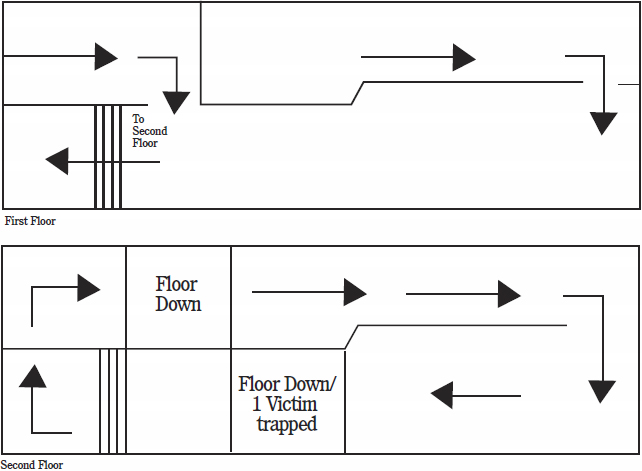
Takes 30-35 first responders approximately 2.0 hours
Required tools: Turnout gear/protective clothing, gloves, boots, head protection, SCBA, hydraulic jacks,
porta power, at least one heavy duty rescue cribbing kit or equivalent, skid sled, backboard or stokes basket,
rope, at least ten hand lights and spare air bottles.
Note: A command post, EMS, and accountability station are required on-site.
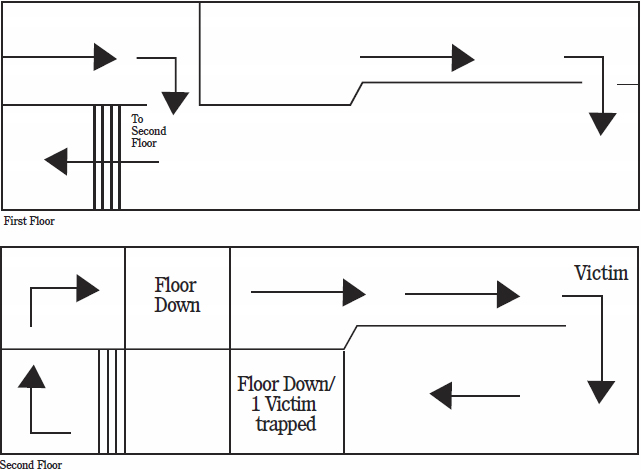
Takes 35-45 first responders approximately 1.5-2.5 hours
Required tools: Turnout gear/protective clothing, gloves, boots, head protection, SCBA, hydraulic jacks,
porta power, at least one heavy-duty rescue cribbing kit or equivalent, skid sled, backboard or stokes basket,
rope, at least ten hand lights and spare air bottles.
Note: A command post, EMS, and accountability station are required on-site.
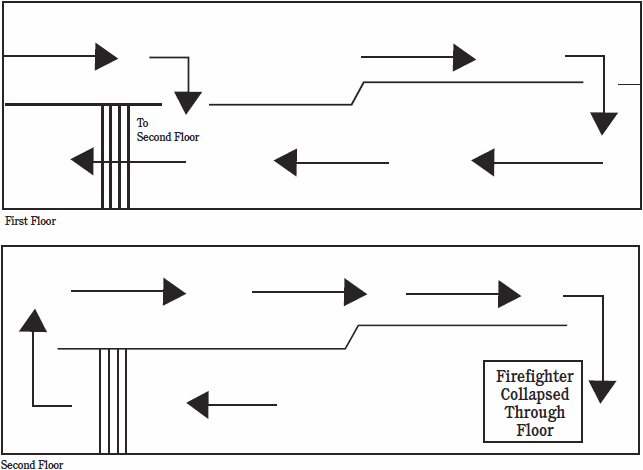
Takes 50+ first responders approximately 3-4 hours
Required tools: Turnout gear/protective clothing, gloves, boots, head protection, SCBA, hydraulic jacks,
porta power, at least three heavy-duty rescue cribbing kits or equivalent, skid sled, backboard or stokes basket,
rope, at least fifteen hand lights, spare air bottles, come-a-long and tools to shut down gas lines.
Optional: Air Bags
Note: A command post, EMS, and accountability station are required on-site.
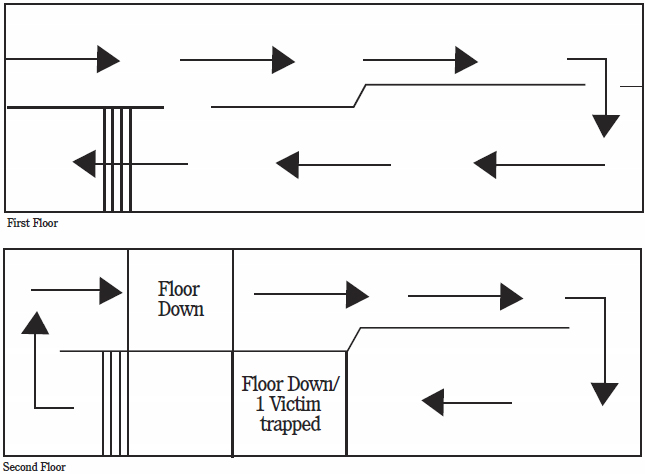
Takes 60+ first responders approximately 4-5 hours
Required tools: Turnout gear/protective clothing, gloves, boots, head protection, SCBA, hydraulic jacks, porta power, at
least three heavy-duty rescue cribbing kits or equivalent, skid sled, backboard or stokes basket, rope, at least fifteen hand
lights, spare air bottles, come-a-long and tools to shut down gas lines.
Optional: Air Bags
Note: A command post, EMS, and accountability station are required on-site.
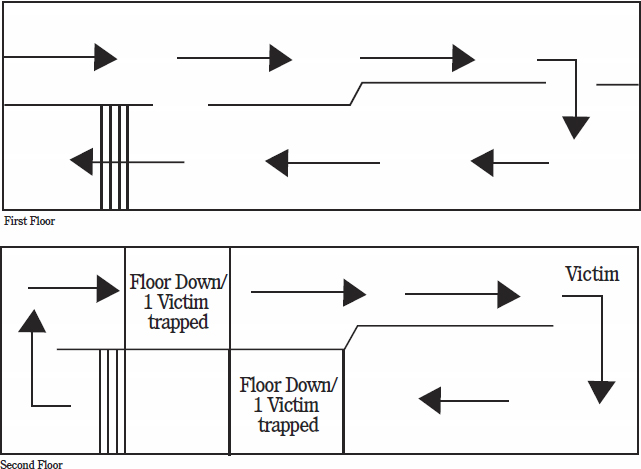
Takes 60-100 first responders approximately 5-7 hours
Required tools: Turnout gear/protective clothing, gloves, boots, head protection, SCBA, hydraulic jacks,
porta power, at least three heavy-duty rescue cribbing kits or equivalent, skid sled, backboard or stokes basket,
rope, at least fifteen hand lights, spare air bottles, come-a-long, tools to shut down gas lines,
5-gallon buckets for removing debris, electric or air jackhammers, short handled shovels,
short column supports, bolt cutter, reciprocating saw, air or electric rotary hammer.
Optional: Air Bags
Note: A command post, EMS, and accountability station are required on-site.
